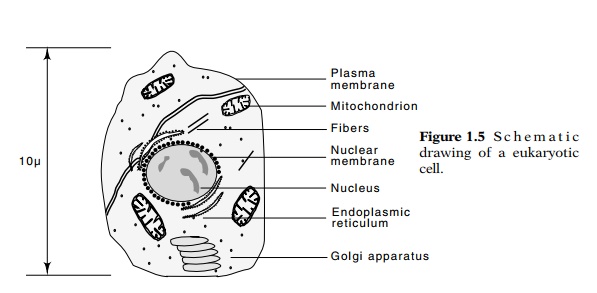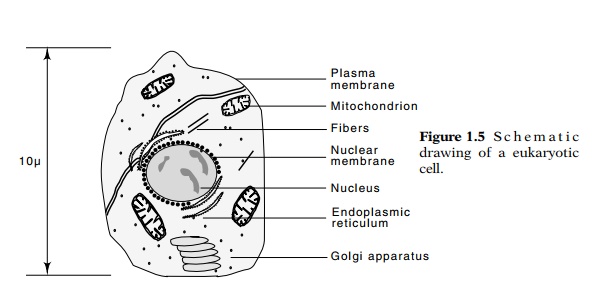Chapter: Genetics and Molecular Biology: An Overview of Cell Structure and Function
Rudiments of Eukaryotic Cell Structure

Rudiments of Eukaryotic Cell Structure
A typical eukaryotic cell is 10 ┬Ą in diameter, making its volume about 1,000 times that of a bacterial
cell. Like bacteria, eukaryotic cells contain cell membranes, cytoplasmic
proteins, DNA, and ribosomes, albeit of somewhat different structure from the
corresponding prokaryotic elements (Fig. 1.5). Eukaryotic cells, however,
possess many structural features that even more clearly distinguish them from
prokaryotic cells. Within the eukaryotic cytoplasm are a number of structural
proteins that form networks. Microtubules, actin, intermediate filaments, and
thin filaments form four main categories of fibers found within eu-karyotic
cells. Fibers within the cell provide a rigid structural skeleton, participate
in vesicle and chromosome movement, and participate in changing the cell shape
so that it can move. They also bind the majority of the ribosomes.
The DNA of eukaryotic cells does not freely mix
with the cytoplasm, but is confined within a nuclear membrane. Normally only
small pro-teins of molecular weight less than 20 to 40,000 can freely enter the
nucleus through the nuclear membrane. Larger proteins and nuclear RNAs enter
the nucleus through special nuclear pores. These are large structures that
actively transport proteins or RNAs into or out of the nucleus. In each cell
cycle, the nuclear membrane dissociates, and then later reaggregates. The DNA
itself is tightly complexed with a class of proteins called histones, whose
main function appears to be to help DNA retain a condensed state. When the cell
divides, a special apparatus called the spindle, and consisting in part of
microtubules, is necessary to pull the chromosomes into the daughter cells.
Eukaryotic cells also contain specialized
organelles such as mito-chondria, which perform oxidative phosphorylation to
generate the cellŌĆÖs needed chemical energy. In many respects mitochondria
resemble bacteria and, in fact, appear to have evolved from bacteria. They
contain DNA, usually in the form of a circular chromosome like that of E. coli

and ribosomes that often more closely resemble
those found in bacteria than the ribosomes located in the cytoplasm of the
eukaryotic cell. Chloroplasts carry out photosynthesis in plant cells, and are
another type of specialized organelle found within some eukaryotic cells. Like
mitochondria, chloroplasts also contain DNA and ribosomes different from the
analogous structures located elsewhere in the cell.
Most eukaryotic cells also contain internal
membranes. The nucleus is surrounded by two membranes. The endoplasmic
reticulum is an-other membrane found in eukaryotic cells. It is contiguous with
the outer nuclear membrane but extends throughout the cytoplasm in many types
of cells and is involved with the synthesis and transport of membrane proteins.
The Golgi apparatus is another structure contain-ing membranes. It is involved
with modifying proteins for their trans-port to other cellular organelles or
for export out of the cell.
Related Topics